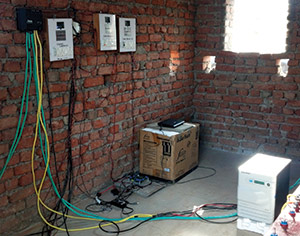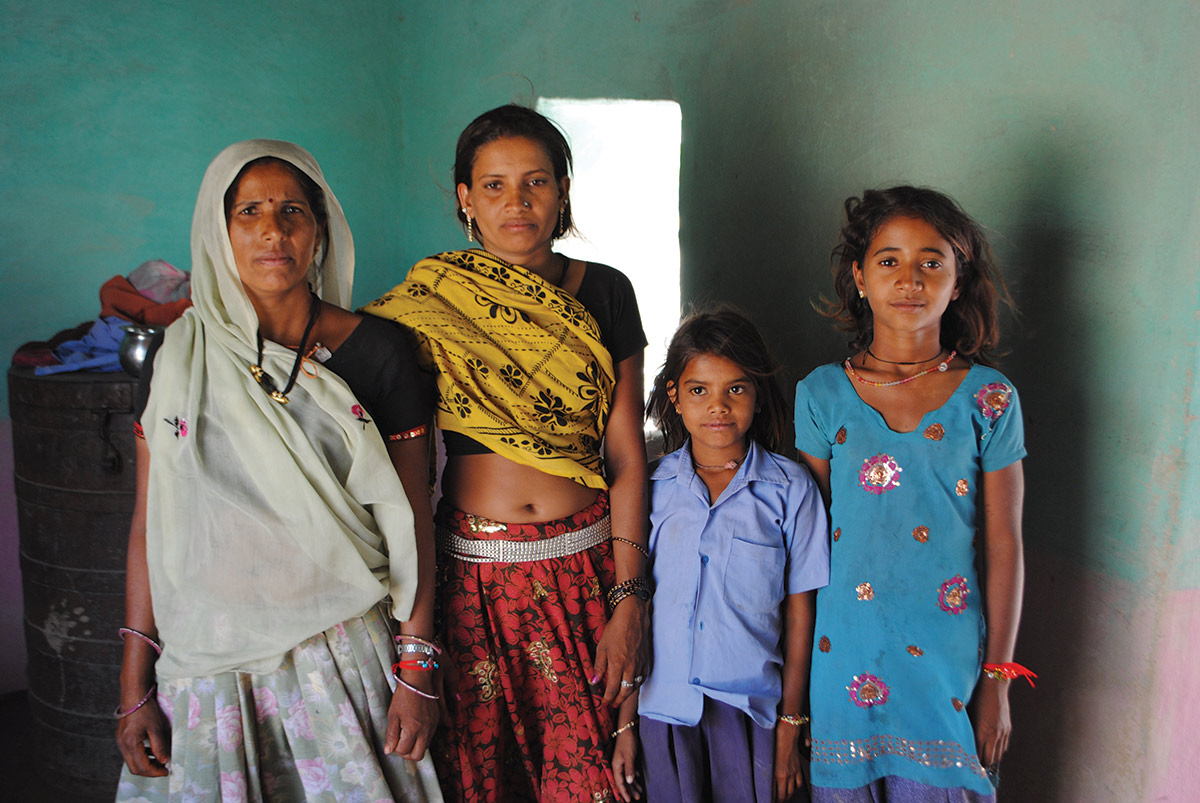
Prepaid power
Over a two-day stretch at the end of July, huge portions of India’s power grid collapsed, causing the world’s largest blackout. Vast swaths of the country went dark; trains stopped, manufacturing halted and hospitals scrambled to fire up backup diesel generators. By the time the lights came back on, 670 million people had been affected.
Only a few weeks before, two recent Berkeley Engineering graduates, Yashraj Khaitan and Jacob Dickinson, had installed a demonstration microgrid 130 kilometers south of Jaipur, Rajasthan, in a region often referred to as the heart of India. While most of the country was dark for those two days in July, the lights in the 15 households connected to their grid shone brightly.
The Rajasthan microgrid project is the latest evolution of a startup called Gram Power. The young company is quickly refining new ways of delivering electricity to places that are too remote or where household energy demand is too low to have cost-effective connections to traditional utility-scale power grids.
“We didn’t want to develop another intermittent solution in the form of a solar lantern or a rechargeable battery, but something that is a full-fledged electrification solution for rural India,” says Khaitan, the founder and CEO of Gram Power. In India alone, the potential market for their services is about 700 million people; globally, it exceeds two billion.
Gram Power is using a clever blend of a business model borrowed from the exploding telecommunications industry and smart meter technology. The venture is also an example of a new wave of international development collaboration, where engineering is the linchpin that connects social science research with development agencies like the United States Agency for International Development (USAID) to build sustainable and useful technologies and create opportunities for economic growth.
An interdisciplinary team back in Berkeley is trying to ride the crest of this new wave. By pooling people and expertise, the Blum Center for Developing Economies, the Center for Effective Global Action (CEGA), the College of Engineering and other research centers on campus are working to create a training program, career path and academic support for development engineers who, like Khaitan and Dickinson, want to turn their talent and education toward finding solutions for the challenges facing some of the world’s most marginalized communities.
While growing up in Jaipur, Khaitan didn’t spend much time outside the city. But in 2008, after his first year in the electrical engineering and computer sciences (EECS) department at Berkeley, he traveled to remote areas around his hometown to do some scouting for a potential class project. “That was the first time I really toured through rural India,” he says. “We identified several projects, and electrification was right up my alley. The impact that reliable and affordable electricity can have on a community was very noticeable.”
When he returned to Berkeley for his second year, Khaitan began developing and designing a modular power system based on an intelligent, micro-storage device, the size of a deck of cards, that he calls M-Power.

Khaitan built and launched about a hundred M-Power units while he was still in school. His idea—design solutions that cater to consumers who require only small amounts of energy—garnered a win at the annual Big Ideas@Berkeley competition and the support of the Blum Center. Soon, other accolades followed. By 2010, Dickinson, a fellow EECS student, joined the project as chief technology officer, and Gram Power was officially born. The team also started working with EECS professor Eric Brewer and his Technology and Infrastructure for Emerging Regions (TIER) group.
Brewer is well-known for his contributions to Internet architecture, but he also spends his time creating innovative information and communications technology for developing economies. For years, through his work with TIER, Brewer has been advocating for a more formalized development engineering trajectory that combines technical training with an understanding of development from a social science perspective.
“Engineers are problem-solvers,” says Brewer. “But we need information to solve problems, and getting that information involves quite a process of discovery.”
The intersection of technology and economics is where Khaitan and Dickinson found themselves when they returned to India as freshly minted graduates in 2011. While they were away, completing their degrees and further developing the M-Power technology, some of their consumers received connections to the Indian grid through government programs. The new access to grid-level electricity, although erratic and unstable, quickly improved their quality of life and fueled a greater demand for energy than M-Power could meet.
Anatomy of a microgrid

Solar power
In one of the village’s household compounds, a centralized solar array collects the sun’s energy and converts it to DC electricity.

Centralized storage
Batteries store the excess solar DC energy and supply users with energy at night and during peak usage.

Monitoring system
The inverter converts DC electricity from solar panels and batteries to AC electricity, which makes it compatible with household appliances. A wireless connection allows Gram Power to detect energy theft or abnormalities and collect data on consumer behavior and consumption patterns.

Smart meter
Each household has a meter that draws energy from the central monitoring system. The meter also keeps track of the amount of prepaid electricity the consumer has remaining, and provides data on the amount of energy a plugged-in appliance is using.
“The trend that we’ve noticed is that people’s standard of living is increasing pretty rapidly after they have access to power,” says Khaitan. “When we set up the system, they opted only to operate a light or two in their homes. But within a couple of weeks they ended up getting access to televisions, fans, coolers and small buttermilk machines.”
After doing more market research and advancing the technology further, Gram Power altered course. “We started to develop the idea of prepaid microgrids; to get the cellular phone model that has revolutionized telecommunications in most of the developing world into the energy sector,” Khaitan says.
Prepaid cell phone follow a model used for fast-moving consumer goods, like tooth-paste or a can of soda, not the typical utility with fixed costs and monthly bills. This means that people with a low or irregular income can become consumers. The shift creates an off-the-charts demand curve for cell phone service purchased in small amounts.
In late 2011, the Gram Power team won another competition, and this one was big. They were selected by NASA, from 10 clean-tech start-ups from around the world, as an idea with tremendous promise. Their success put them on the radar of USAID and angel funders. Soon after the nod from NASA, they secured the first round of seed funding to continue research and development.
The result is Gram Power’s current microgrid. It is powered by centralized solar panels and has an AC inverter, a battery storage array and a smart meter attached to each user’s home. Besides being clean and reliable, the microgrid allows consumers to purchase small amounts of energy from a local entrepreneur who uses a wireless system that Khaitan calls an “energy wallet” to reload the meter.
Gram Power consumers get direct feedback from the meters. They can plug in devices, like an incandescent light bulb, and the meter will tell them how much energy the light draws. They can then compare that to alternatives, like a compact fluorescent bulb. The prepaid model and feedback about decisions offer consumers tools for conserving energy, unlike other energy grids that often charge a flat fee, stripping the incentive to save. As users start to conserve, Khaitan says, “We ourselves are surprised by the number of connections we are able to provide with the amount of power we can generate.”
The smart grid is also connected wirelessly to a remote monitoring system, so Khaitan can detect attempts at energy theft or technical problems from his office in Jaipur. As with M-Power, users connected to the microgrid can tailor their energy decisions based on their weekly cash flow and scale their use accordingly.
Khaitan had plans to return to Berkeley this fall to finish his master’s degree and continue on with a Ph.D., but because of Gram Power’s rapid growth,
he has decided to stay in India and run the company full time. His connections to the university, however, are still close. Khaitan participates in regular meetings with Brewer, TIER, the Blum Center and the Center for Effective Global Action (CEGA). They figure out how Berkeley’s development economists can make use of data collected from Gram Power’s engineering project. The information has a range of benefits.
“This is a model project,” says Temina Madon, CEGA’s executive director, a research hub for development economists. “We are building in randomized pricing experiments to the deployment of new smart grids. As we learn how people make decisions about power consumption, the technology can be redesigned. We can change the metering systems, the payment plans and the plant’s generation and storage capacity. So we can help inform refinements to the technology using social science.”
At the same time, the collaborators are seeking to partner with USAID to start a new center on campus, which would create a development engineering Ph.D. track and career path. Gram Power is one of several projects that offer a concrete example of what the new hybrid model of engineering and development economics would look like. “Together, I think we have a lot of promise to create solutions for development that go beyond widgets or gadgets,” says Madon.
In the meantime, Gram Power continues building microgrids in Rajasthan. By summer’s end, Khaitan and Dickinson were connecting the remaining households at their first test site to their grid. Now, about 30 households, or 200 people, have clean and reliable electricity.
Given the context of India’s recent epic infrastructure failure and blackout, what started as a simple beta test for Gram Power’s new technology has suddenly become a metaphor for a larger proof of concept—smart infrastructure, on a different scale, as a way forward for India and elsewhere. Khaitan is already working with India’s Smart Grid Forum, a public-private partnership.
“A lot of the guidelines they have for the next 15 or 20 years are systems we have implemented on a micro scale in our microgrid,” says Khaitan. “But we plan on getting all of these systems on the main grid as well.”































